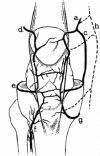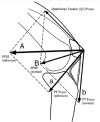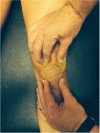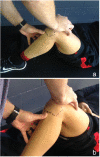Evaluation, Treatment, and Rehabilitation Implications of the Infrapatellar Fat Pad
- PMID: 26502189
- PMCID: PMC4789926
- DOI: 10.1177/1941738115611413
Evaluation, Treatment, and Rehabilitation Implications of the Infrapatellar Fat Pad
Abstract
Context: The infrapatellar fat pad (IFP) is in the anterior knee compartment and may be a major pain generator.
Evidence acquisition: A PubMed database search using the terms Hoffas fat pad, anterior interval, and infrapatellar fat pad was performed from the years 1970 to 2015.
Study design: Clinical review.
Level of evidence: Level 5.
Results: Limited research exists examining the role of the IFP in relation to potential treatment and rehabilitation implications.
Conclusions: Alterations in IFP mobility, whether the result of postsurgical scarring or faulty movement patterns, result in pain and disability in a variety of patient populations. The majority of treatment approaches are driven by the surgical technique.
Keywords: Hoffas fat pad; anterior knee pain; infrapatellar fat pad.
© 2015 The Author(s).
Conflict of interest statement
The authors report no potential conflicts of interest in the development and publication of this article.
Figures








References
-
- Ahmad CS, Kwak SD, Ateshian GA, Warden WH, Steadman JR, Mow VC. Effects of patellar tendon adhesion to the anterior tibia on knee mechanics. Am J Sports Med. 1998;26:715-724. - PubMed
-
- Bohnsack M, Hurschler C, Demirtas T. Infrapatellar fat pad pressure and volume changes of the anterior compartment during knee motion: possible clinical consequences to the anterior knee pain syndrome. Knee Surg Sports Traumatol Arthrosc. 2005;13:135-141. - PubMed
-
- Bohnsack M, Meier F, Walter GF, Hurschler C, Schmolke S, Wirth CJ. Distribution of substance-P nerves inside the infrapatellar fat pad and the adjacent synovial tissue: a neurohistological approach to anterior knee pain syndrome. Arch Orthop Trauma Surg. 2005;125:592-597. - PubMed
-
- Bohnsack M, Wilham A, Hurschler C. Biomechanical and kinematic influences of a total infrapatellar fat pad resection of the knee. Am J Sports Med. 2004;32:1873-1880. - PubMed
-
- Donell ST. The synovial folds of the patellofemoral joint: a dynamic study. Clin Anat. 1992;5:107-112.
Publication types
MeSH terms
LinkOut - more resources
Full Text Sources
Other Literature Sources
Medical
Research Materials

